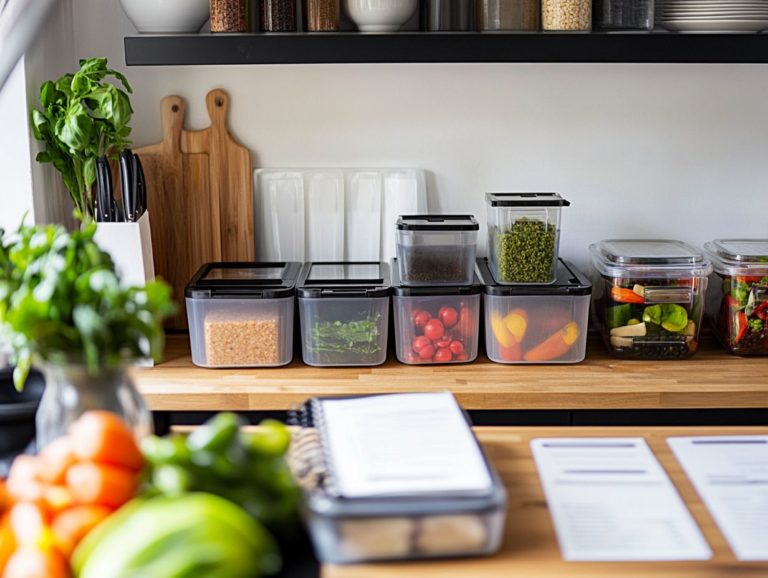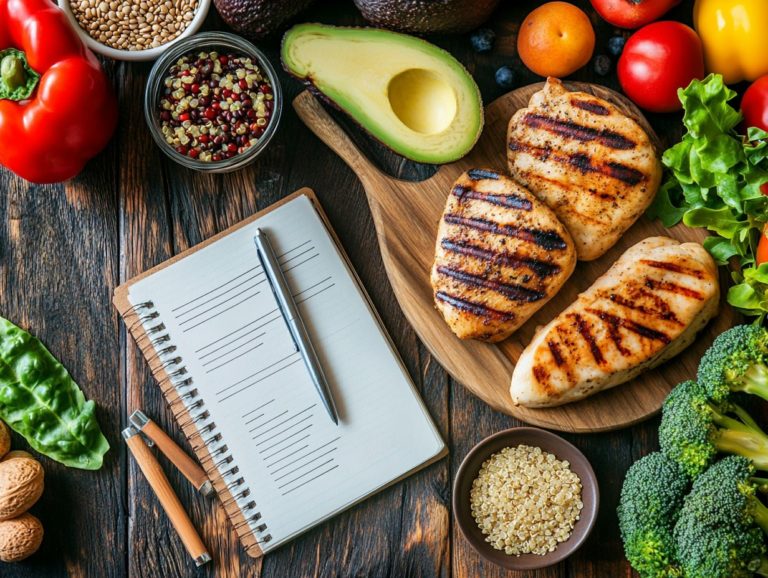5 Essential Spices for Meal Planning
Spices have the remarkable ability to transform an ordinary dish into a culinary masterpiece. Selecting the right ones for your meal planning can significantly enhance both flavor and health. Don t miss out on the incredible flavors and health benefits these spices can bring to your meals!
Consider incorporating five essential spices cumin, turmeric, paprika, cinnamon, and ginger into your repertoire. Uncover their impressive health benefits, learn how to effortlessly weave them into a variety of cuisines, and discover expert tips for purchasing and storing these flavorful staples.
Regardless of whether you re a seasoned chef or just beginning your culinary journey, these spices will ignite your creativity in the kitchen.
Contents
- Key Takeaways:
- 1. Cumin
- 2. Turmeric
- 3. Paprika
- 4. Cinnamon
- 5. Ginger
- How to Incorporate These Spices into Your Meal Planning?
- Frequently Asked Questions
- What are the 5 essential spices for meal planning?
- Why are these 5 spices considered essential for meal planning?
- Can these 5 spices be substituted with other spices?
- How can I incorporate these 5 essential spices into my meal planning?
- Are there any health benefits to using these 5 essential spices?
- Can I store these 5 essential spices for a long time?
Key Takeaways:

- Spice up your meal planning with the essential spices of cumin, turmeric, paprika, cinnamon, and ginger.
- Not only do these spices add flavor to your dishes, but they also offer numerous health benefits.
- Experiment with incorporating these spices into different types of dishes and combining them to create delicious and unique flavors.
1. Cumin
Cumin is a remarkably versatile spice that is used in many cuisines. It is celebrated for its warm, earthy flavor that elevates your dishes and brings a host of health benefits.
Packed with antioxidants, it promotes overall wellness. It’s a star ingredient in spicy curries, hearty stews, and aromatic rice dishes, often harmonizing beautifully with coriander, garlic, and chili.
Imagine savoring traditional recipes like Indian dal, where lentils are infused with spices, or enjoying Mexican tacos, where cumin complements the richness of the meat.
From a nutritional standpoint, cumin is a powerhouse, rich in iron, aiding digestion, and strengthening the immune system. Utilizing traditional roasting techniques can further enhance its natural oils, intensifying its flavors.
Cumin is a key ingredient in spice blends like garam masala and taco seasoning, ensuring that your culinary creations are nothing short of exceptional.
2. Turmeric
Turmeric, with its vibrant golden hue and distinctive flavor, has long been hailed as a powerful health ally. It’s brimming with antioxidants and anti-inflammatory properties that can elevate both your culinary creations and overall well-being.
Incorporating this remarkable spice into your meals is easy and incredibly rewarding, making it a cherished ingredient across diverse cuisines. Whether you’re whipping up traditional Indian curries or blending modern smoothies, turmeric enhances flavors, adding a warm, earthy note.
Many cultures regard it as more than just a culinary staple; they see it as an important part of their medicine, harnessing its healing qualities in daily life.
If you’re ready to spice things up, try these recipes: turmeric rice, golden milk lattes, or refreshing roasted vegetables. These dishes showcase how seamlessly this spice can integrate while honoring its rich cultural significance.
3. Paprika
Paprika, that enchanting spice derived from dried red peppers, is your secret weapon for adding depth and vibrant color to your culinary creations. It s a staple in meal prep, gracing everything from Hungarian goulash to Spanish paella with its charm.
This versatile spice comes in several varieties, each boasting its own unique flavor profile.
- Sweet paprika offers a mild flavor that enhances your dishes without overshadowing them.
- If you’re in the mood for something more adventurous, smoked paprika brings a rich, smoky essence, elevating everything from meats to roasted vegetables.
- And for those who crave a little heat, hot paprika delivers a spicy kick that can transform a simple meal into a tantalizing treat.
Incorporating paprika into your recipes is a breeze. Sprinkle it on deviled eggs for a pop of color, stir it into stews for a warm, complex flavor, or blend it into marinades for grilling.
Its vibrant red hue not only enhances the flavor but also creates a visual feast, making each dish a delight for both the palate and the eyes.
4. Cinnamon
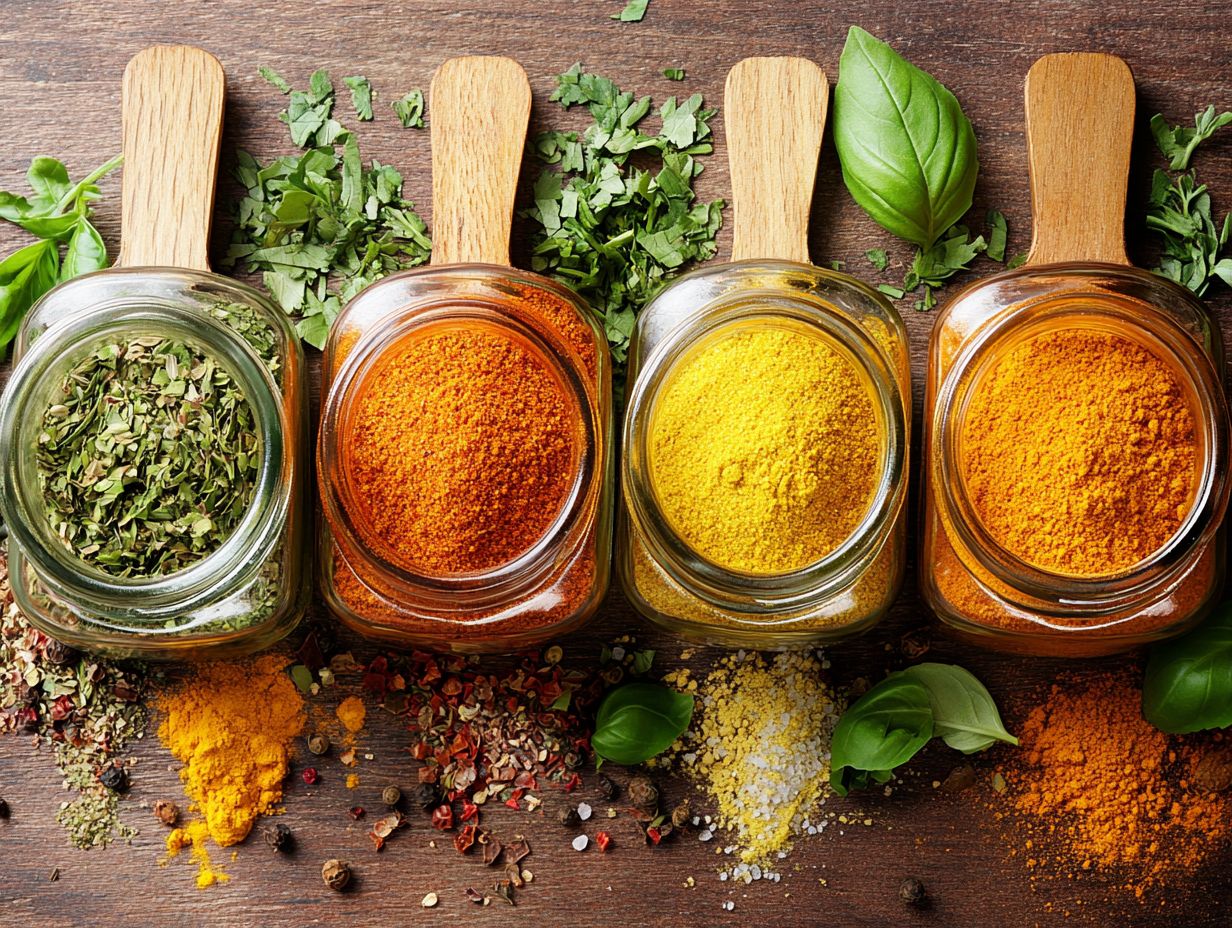
Cinnamon has a warm, sweet aroma. It s much more than just a beloved spice; it offers many health benefits, including balancing blood sugar levels.
This spice shines in sweet treats like cinnamon rolls and spiced apple pie. It also complements savory dishes. From Moroccan tagines to spicy chilis, cinnamon is essential in your pantry.
With a variety of recipes available from cinnamon-infused oatmeal to spiced roasted vegetables you can explore endless culinary possibilities. Many cultures have celebrated cinnamon for its rich history and healthful properties.
5. Ginger
Ginger enhances your cooking with its zesty flavor. Think of it as your natural health ally that aids digestion and boosts immunity.
Ginger comes in many forms: fresh, dried, and powdered. Fresh ginger adds warmth to marinades, while dried ginger is perfect for cookies and cakes.
Ground ginger plays a key role in spice blends and teas, offering a soothing effect on the stomach. Numerous recipes, such as ginger-infused stir-fry and classic ginger tea, showcase its vibrant profile.
Beyond its delightful flavor, ginger is known for its anti-inflammatory properties and ability to alleviate nausea. This makes it a cherished staple in both kitchens and herbal medicine cabinets.
How to Incorporate These Spices into Your Meal Planning?
Incorporating spices like cumin, turmeric, paprika, cinnamon, and ginger can elevate your cooking. These spices enhance flavor and boost nutritional value.
To seamlessly integrate these spices into your weekly meal prep, craft a spice mix each week that customizes combinations based on your planned proteins or vegetables. For example, cumin and paprika pair wonderfully with roasted chicken.
Don t overlook the power of various cooking methods. Whether you saut , roast, or grill, each technique brings out unique characteristics of the spices that can elevate your meals.
To keep things exciting, alternate between sweet and savory dishes to maintain a delightful flavor balance that keeps your palate engaged. This approach opens the door to endless variations, ensuring every mealtime remains fresh and enjoyable.
What Are the Health Benefits of These Spices?
The spices cumin, turmeric, paprika, cinnamon, and ginger are packed with health benefits. They provide antioxidants that boost your immune system and improve digestion.
Research has spotlighted turmeric’s active compound, curcumin, known for its impressive anti-inflammatory effects. This is particularly beneficial for those grappling with chronic inflammatory conditions.
Cinnamon is linked to enhanced insulin sensitivity and better blood sugar control, proving to be a valuable ally for anyone monitoring their metabolic health.
Cumin aids digestion and boasts a high iron content, crucial for maintaining energy levels. Paprika delivers a healthy dose of vitamin A, essential for eye health, while ginger is celebrated for its ability to ease nausea and digestive discomfort.
By weaving these spices into your daily meals, you can effortlessly elevate your nutritional intake, fostering a more balanced and health-conscious diet.
What Types of Dishes Can These Spices Enhance?
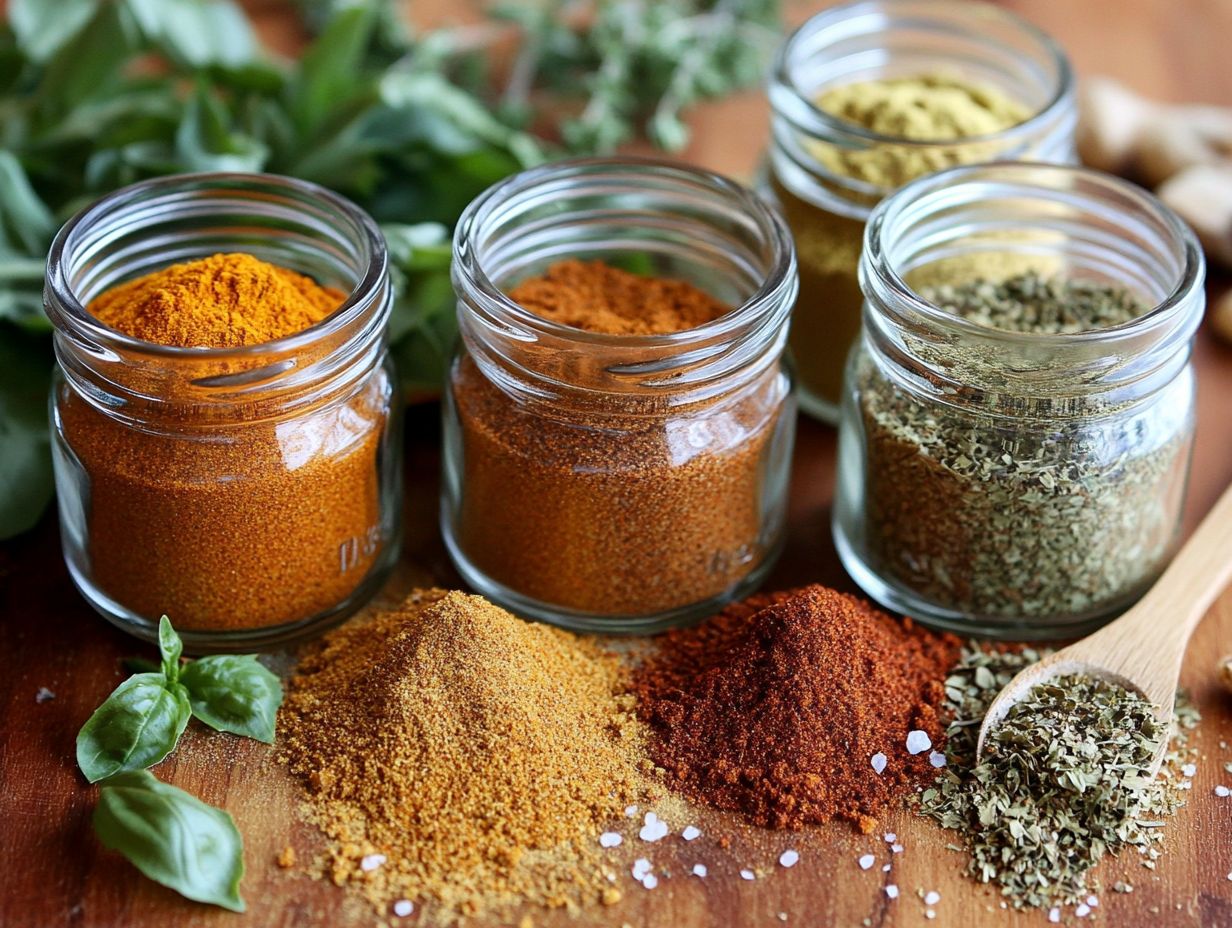
Cumin, turmeric, paprika, cinnamon, and ginger can elevate your culinary creations by adding rich flavors and aromas. They enhance everything from hearty stews to luscious desserts, showcasing their remarkable versatility.
For example, when you add a dash of cumin to your chili, it becomes irresistibly enticing. Turmeric imparts a stunning golden hue and earthy depth to coconut curries. These spices do more than just add flavor; they ignite your creativity. Picture cinnamon dancing through a spiced apple pie or ginger breathing new life into a classic carrot cake.
Transforming traditional recipes is easy. A sprinkle of paprika can take a simple roasted chicken with a spicy twist and turn it into something spectacular. Whether you’re whipping up Middle Eastern falafel or savoring a cup of Indian chai, these spices invite you to explore the culinary landscape, turning everyday meals into extraordinary experiences.
How Can These Spices Be Used in Combination?
By using spices like cumin, turmeric, paprika, cinnamon, and ginger together, you can create exciting flavor pairings and robust seasoning blends that enhance your meals and open the door to endless culinary creativity.
Each spice contributes its unique character and warmth, making them ideal for various dishes. For instance, a warm blend of cumin, turmeric, and paprika can elevate a simple chickpea stew, infusing it with depth and vibrancy. Alternatively, when you combine cinnamon and ginger with cumin, you create a fragrant marinade that pairs beautifully with grilled chicken or vegetables.
Feel free to experiment! A chai-inspired blend of cinnamon, ginger, and a hint of paprika can turn an ordinary cup of tea into a warming, flavorful experience. The art of seasoning lies in achieving balance, and thoughtfully mixing these spices offers an exciting journey through the world of flavors.
What Are Some Tips for Buying and Storing These Spices?
When buying and storing spices like cumin, turmeric, paprika, cinnamon, and ginger, prioritize high-quality products and proper storage to preserve their flavor and nutritional benefits over time.
Choose spices from reputable sources, such as specialty shops or farmers’ markets, to enhance their freshness and potency. Look for fresh herbs that showcase vibrant colors and rich aromas, while dried spices should be aromatic and free of any discoloration or clumps.
To ensure maximum shelf life, store these precious condiments in airtight containers. Keep them away from light and humidity that can compromise their quality. Regular checks for signs of fading flavor will help you confirm their effectiveness in your culinary creations, elevating your dishes with authentic taste and nutritional value.
How Can These Spices Be Used in Different Cuisines?
Cumin, turmeric, paprika, cinnamon, and ginger are essential spices that grace kitchens across the globe. Each brings its own culinary flair and flavor profile that showcases its unique qualities.
Take cumin, for instance. It s a cornerstone in Middle Eastern fare like falafel, adding a warm, earthy note that beautifully complements fresh herbs like cilantro. Then there’s turmeric, a gem in Indian cuisine renowned for its vibrant color and health benefits. It often dances in harmony with fresh curry leaves and ginger, creating rich curries that tantalize the palate.
Paprika, with its smoky allure, takes center stage in Spanish paella, mingling with colorful bell peppers and fresh parsley. This elevates the dish to new heights. Cinnamon effortlessly straddles the line between sweet and savory, finding its way into Moroccan tagines alongside fresh mint, adding layers of depth and complexity. Lastly, ginger is a must-have in Asian stir-fries, where it partners with scallions to create a bright, aromatic profile that defines countless traditional dishes.
Frequently Asked Questions
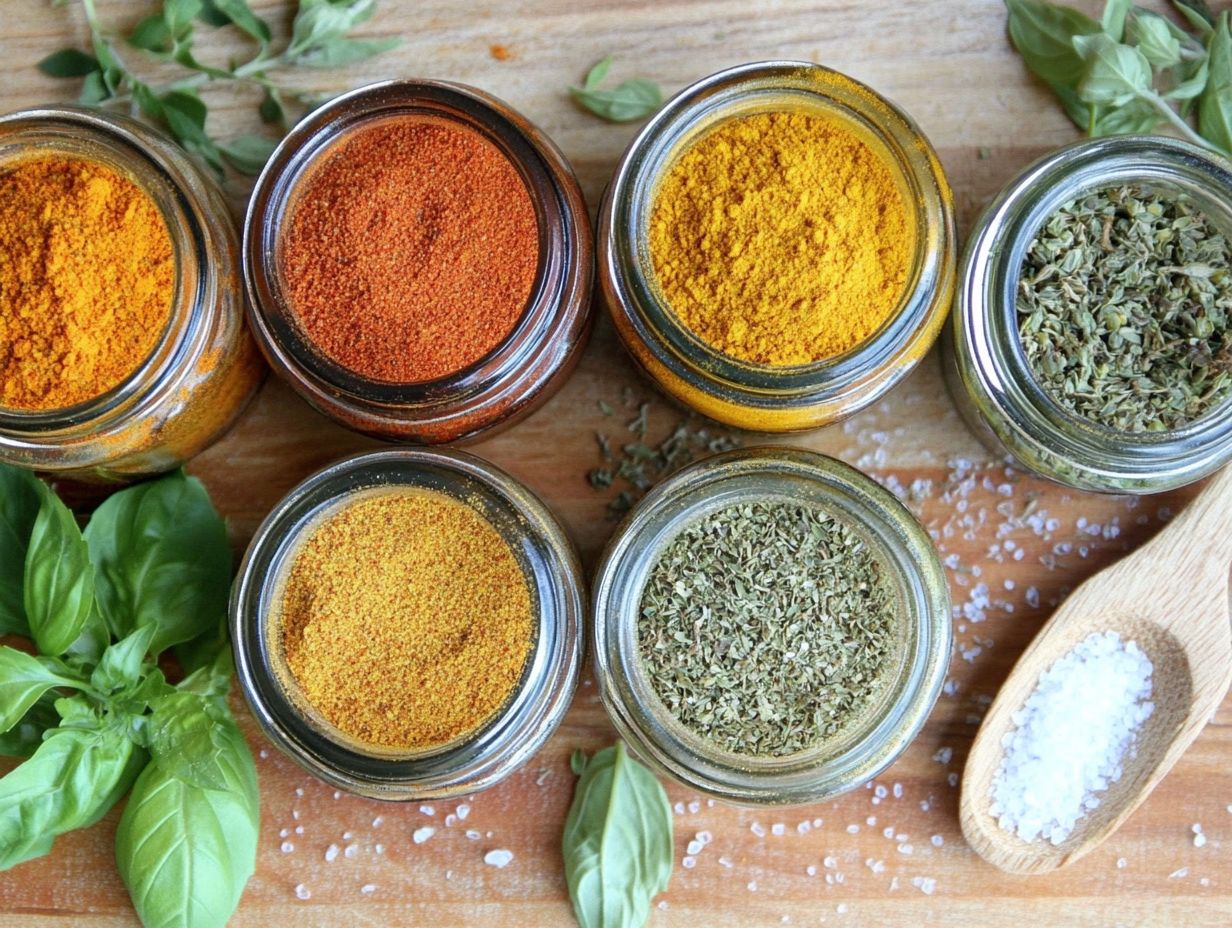
What are the 5 essential spices for meal planning?
The 5 essential tools for successful meal planning include not just spices like salt, black pepper, garlic powder, onion powder, and cayenne pepper, but also other key items that can enhance your cooking experience.
Why are these 5 spices considered essential for meal planning?
These spices are essential for meal planning because they add flavor and depth to a variety of dishes. They are versatile enough to be used in a wide range of cuisines.
Can these 5 spices be substituted with other spices?
You can substitute these spices with others to suit your individual tastes. For example, try using smoked paprika instead of cayenne pepper for a milder spice level.
How can I incorporate these 5 essential spices into my meal planning?
Incorporate these spices into your meals today for delicious flavor! Use them in marinades, rubs, or as seasoning for meats, vegetables, soups, and stews.
Are there any health benefits to using these 5 essential spices?
Yes! These spices not only add flavor to your meals but also provide health benefits.
For instance, black pepper helps reduce inflammation, and garlic powder fights bacteria.
Can I store these 5 essential spices for a long time?
Absolutely! You can store these spices for a long time if kept in airtight containers in a cool, dry place away from direct sunlight. They can last up to 2-3 years when stored correctly.
Try using these spices in your next meal and discover new flavors!

